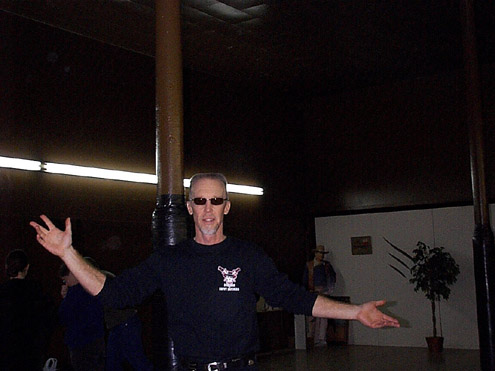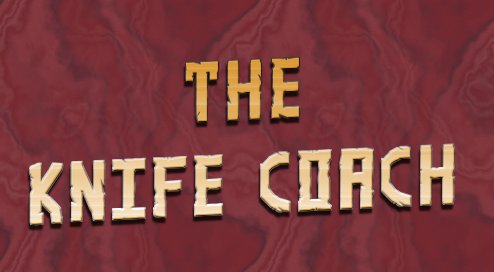
 | ||||||

 | ||||||
Hello and Welcome to Session #5 of the On-going Comtech KNIFE COACH SUMMER SESSIONS STUDIES!
.................................................
In this installment we shall closely observe the Concepts underlying the Rotary Cutting Principles that are taught as an intermediate level skill...
TM
ROTARY CUTTING CONCEPTS
Greetings and salutations to you! Welcome to this weeks training session with James Keating / The "Knife Coach"! This is about you and me in a one to one setting using the mediums of our computers, the printed word and the visual guides of video to train in a variety of defensive edged weapon skills together. This is a monumental opportunity for growth and comradery for those of us upon the thousand mile path of the warrior. If these sessions can help to motivate you, inspire you, enhance your skills or give you hope in some manner then my job is done. Mission accomplished!
Ok, I don't know about you, but I'm excited to get going. We have a full plate of tactical training that we must discuss as well as then practice it!
Some cuts can be slashes, some cuts can be snapped, some cuts can be drawn and numerous other cuts can be described in any number of ways (including foreign terms, pet nicknames, etc) And then there is the family of cutting called "Rotary Cutting". And it is the rotary action of advanced knife play that we will be focusing upon in this lesson. As one who is out to master the knife such as your humble self seems to be, you must know the linear, the circular, the spiral, the outgoing and the incoming pathways that the knife encompasses. Each area should be closely analyzed and studied as a specific skill. This is in order to develop your greater overall abilities once all of the separate skills are brought together at a later date.
As you already know "Rotary" refers to a form of circular motion. For us it's a specific type of circular motion that lends itself to our particular needs as knifemen. The most popular and most well known rotary motion that some of you already know is the one we learn from practicing the basic #1 Drawpoint DVD material. It's called "rotary picking". Rotary actions can be done while in close quarters (touch range) or they can be done at long (largo) range. Know this and practice accordingly, be well rounded in both your physical skills and your intellectual knowledge regarding the blade art of your choice. Know that in many of the methods (not all of them) I am espousing in this session the checking hand is often used to augment the actions of the blade.
Rotary action can happen on any of the eight planes of motion. (IE: Diagonal, Vertical, horizontal, upwards, downwards etc). You should be adept on any plane of movement. Learn on the horizontal and vertical planes initially. Once those two simple lines are covered then you can do the others easily. In combination with your close quarter rotary knife skills you will also wish to hone your adherence and sensitivity skills.
In Kung fu circles this feeling is called "sticking energy". In some instances the opponent must be repelled away, and in other situations it may be better to adhere - to stick to them and do your damage from that vantage. Adherence takes some practice, but once you get the idea it isn't long before you are doing it well enough. Sticking to an adversary can confuse and frustrate (suffocate) their abilities. Adherence reduces their chances and opens up tactical advantages for you / the interplay between repelling and adhering must be intimately understood! To gain a deeper understanding of this "interplay" of forces you might consider researching something from Tai Chi Chuan known as "severing the root" (see 7D) and learn how it is accomplished.
Rotary principle must also be studied as part of the disengagement skills that you employ in both close quarter knife to knife play and empty hand versus the blade in counter-knife work as well. The disengage is a basically a horizontal circle that dips and evades. A "rotary disengage" can alter it's direction or angle of travel very quickly and carries surprising authority (power)when done correctly. This is one reason why we knife fighters use it due to it's valuable tactical versatility. But it is not a move for a novice, it requires lots of practice.
In a move such as the well known "redondo" (rolling cut) the checking hand is optional. You can use it or not, range dictates usage of the live hand. The redondo is a rotary action done with a whip-like arcing motion. It is normally done in a forwards action, but can be done reverse too. It is such a important motion for the practioner of edged action that it occupies it's own unique place in the knife fighters arsenal. Why would this be so you may ask?
The common redondo can handle anything - any angle of attack. It is a universal workhorse, non-specific in it's duties, it can be used at any time against any attack. In times of great stress when the tide of combat seems to be turning against you the redondo is somewhat like a "panic-button". When you can remember little or nothing of your true training (due to panic/fear/injury) then you MUST refer to the redondo. This kind of dire situation can happen, that is why the redondo is there. To save you, to pull your fat from the fire and save the day. It is a simple move, so learn it well in all of it's many forms. If nothing else it makes a great "respect getter" for keeping multiple opponent's at bay.
The family of motion known in the FMA as "slanting" (or also called the shield (paiyon / pai-own) and roof (sombria) actions) are rotary in nature as well. The are sophisticated rotary motions due to the fact that the wrist must make an articulated roll in accompanyment to the rotary technique itself. When the actions are pieced together they form a horizontal figure eight and can be employed as such. The "slantings" are normally done on the diagonal planes. The slant provides the counter-cut and the deflection of their attack all in one rotational axis. Fast, effective and surprising, it is no wonder that many knife systems share a postive opinion about the slanting family. If any of you know the exercise called "Sumbrada" - then you will also recognize that 3 out of the 5 moves in the Sumbrada drill are of the slanting variety.
Double knife rotary motion can begin to appear like the rotary punch's of Wing Chun Gung Fu. Or instead it can appear like a modified heaven six sinawalli action. With sharps (sharp knives) this can be silly & dangerous to try in a fight and besides it is beyond the scope of this session anyhow. Knife Coach sez "lets pass" on rotary double knives for now. Maybe something for a later date. But thanks for asking about it!
A true professional of the knife must be more than just a player of the common slash and dash. A true expert of the blade is a person of character, skill and depth. To cultivate these positive traits as you advance in your training and to avoid the pitfalls that out of control ego and pride bring upon you is what it's really all about if you are to succeed. Without these positive elements being present in everything you do in the course of your normal training then you are nothing more than a threat to society and to yourself. Nothing special, just a common killer (and the world has too many of those already). A great blade must belong to a great man. They go together. Understand? ... Good!
I'll meet you upon the high road again my friend, for it is the only road our kind can travel (right?). And then we will make another foray into the protective circle of knowledge and light to once again come forth renewed and ready for whatever challenges life may choose to send our way ....
Stay sharp and Salute Out!
KNIFE COACH
Session # 5